- Biodegradable plastics
- Compostable plastics
- Marine or soil degradable plastics
-
Bioplastics Ambiguous term due to multiple definitions, see Bioplastics Clarification Page for more information
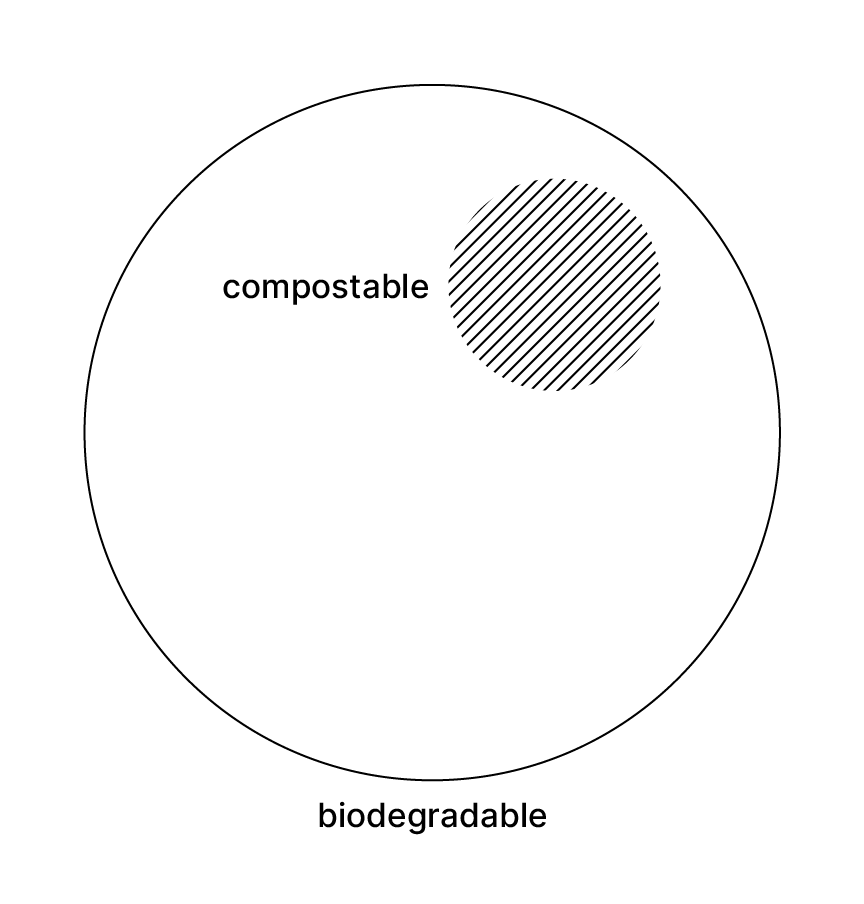
Biodegradable plastics are plastics that can be broken down by microorganisms like bacteria and fungi into water, carbon dioxide, and other molecules found in nature. They can be made from conventional, fossil fuel feedstocks, biological feedstocks like potato starch, or both (see the bioplastics clarification page for distinctions between biodegradable and bio-based plastics).
“Biodegradable,” therefore, refers to end-of-life behaviour, regardless of the materials used to make the plastic. Different biodegradable plastics require different amounts of heat, oxygen, moisture, and sunlight to actually break down into organic materials. Depending on environmental conditions, biodegradable plastics may or may not break down as intended, and evidence suggests that under many circumstances they fail to do so in a reasonable amount of time in the real world.((Haider, T., Völker, C., Kramm, T., Landfester, K., Wurm, F. (2018). Plastics of the Future? The Impact of Biodegradable Polymers on the Environment and on Society. Angewandte Chemie, 58(1), 50-62. https://doi.org/10.1002/anie.201805766))((Napper, I., Thompson, R. (2019). Environmental Deterioration of Biodegradable, Oxo-biodegradable, Compostable, and Conventional Plastic Carrier Bags in the Sea, Soil, and Open-Air Over a 3-Year Period. Environ. Sci. Technol. 53(9), 4775–4783. https://doi.org/10.1021/acs.est.8b06984))((Nazareth, M., Marques, M.R., Leite, M.C., Castro, I.B. (2019). Commercial plastics claiming biodegradable status: is this also accurate for marine environments? J. Hazard. Mater. 366, 714–722. https://doi.org/10.1016/j.jhazmat.2018.12.052))((UNEP. (2015). Biodegradable Plastics and Marine Litter. Misconceptions, concerns and impacts on marine environments. United Nations Environment Programme (UNEP).))
Compostable plastic is a type of biodegradable plastic that is certified to break down under specific conditions, like those of an industrial composting facility. In this way, all compostable plastics are biodegradable, but not all biodegradable plastics are compostable. Laws like the European Union’s EN 13432 or the American ASTM D6400 compostability standard set requirements for a plastic material to qualify as compostable, including inherent biodegradability, a test on compostability in operational conditions, and a guarantee that the material is free of dangerous levels of heavy metals and does not negatively impact compost quality.
Most compostable plastics are only certified to break down in the specialized conditions of industrial composting facilities, and, like non-compostable biodegradable plastics, may not break down in home composting piles or the open environment.
A few countries (e.g. France) have adopted standards for “home-compostable” plastics, which require degradation to occur at a lower temperature, but the potential benefits of such standards are limited by consumer access to well-managed compost piles, varying temperatures across climate zones, consumer confusion about home vs. industrial composting certification, and a lack of international consensus on testing criteria.
Examples
Bans & Restrictions
While there are currently no major bans specifically addressing biodegradable or compostable plastics, some jurisdictions have banned single-use plastics or thin plastic bags made from any type of plastic, including biodegradable and compostable plastics.((Directive (EU) 2019/904 of the European Parliament and of the Council of 5 June 2019 on the reduction of the impact of certain plastic products on the environment. https://eur-lex.europa.eu/eli/dir/2019/904/oj))((Greenpeace Africa. (2020, May 19). 34 Plastic Bans in Africa | A Reality Check. Greenpeace. https://www.greenpeace.org/africa/en/blogs/11156/34-plastic-bans-in-africa/))((Fiji Ministry of Waterways and the Environment. Plastic Ban. https://www.mowe.gov.fj/plastic-ban/))((Shallcross, J. (2019, October 24). Mexico’s Most Popular Destinations Are Banning Single-Use Plastics Starting in 2020. AFAR. https://www.afar.com/magazine/single-use-plastic-bans-in-mexico-what-travelers-need-to-know))((Masterson, V. (2020, October 26). As Canada bans bags and more, this is what’s happening with single-use plastics around the world. World Economic Forum. https://www.weforum.org/agenda/2020/10/canada-bans-single-use-plastics/))((Jamaican National Environment and Planning Agency. (2018, September 24). Plastic Bags, Straw and Polystyrene Ban. Jamaica Information Service. https://jis.gov.jm/information/get-the-facts/plastic-bags-straw-and-polystyrene-ban/)) Other jurisdictions with similar bans exempt bags or single-use plastics made from biodegradable and/or compostable materials.((Directive (EU) 2015/720 of the European Parliament and of the Council of 29 April 2015 amending Directive 94/62/EC as regards reducing the consumption of lightweight plastic carrier bags. https://eur-lex.europa.eu/legal-content/EN/TXT/?qid=1601561123103&uri=CELEX:32015L0720 ))((Masterson, V. (2020, October 26). As Canada bans bags and more, this is what’s happening with single-use plastics around the world. World Economic Forum. https://www.weforum.org/agenda/2020/10/canada-bans-single-use-plastics/))((Greenpeace Africa. (2020, May 19). 34 Plastic Bans in Africa | A Reality Check. Greenpeace. https://www.greenpeace.org/africa/en/blogs/11156/34-plastic-bans-in-africa/))
Assessment
Substituting conventional plastics with biodegradable plastics((Other biodegradable alternatives, like bags made from natural fibers, have been used in many countries long before the advent of plastics, and are becoming more popular among zero waste advocates as more sustainable alternatives to plastics.)) would not help reduce plastic waste, and could even hamper current waste recovery efforts. Neither compostable nor biodegradable plastics are intended or well-suited for reuse, as they are designed to degrade more readily than conventional plastics. For this same reason, biodegradable plastics can reduce the quality of mixed recyclable materials,((Samper, M., Bertomeu, D., Arrieta, M., Ferri, J., & López-Martínez, J. (2018). Interference of Biodegradable Plastics in the Polypropylene Recycling Process. Materials, 11(10), 1886. http://dx.doi.org/10.3390/ma11101886))((Alaerts, L., Augustinus, M., & Van Acker, K. (2018). Impact of Bio-Based Plastics on Current Recycling of Plastics. Sustainability, 10(5), 1487. http://dx.doi.org/10.3390/su10051487)) and are sometimes considered contaminants in recycling systems. When composted, non-compostable biodegradable plastics are not guaranteed to break down completely, and can leave behind partially degraded fragments and microplastics in the resulting compost.
When littered in the open environment, biodegradable plastics can be just as problematic as conventional plastics. Many studies show that biodegradable plastics fail to fully biodegrade in real world environments, and can remain intact for years before fragmenting into equally persistent microplastics.((Haider, T., Völker, C., Kramm, T., Landfester, K., Wurm, F. (2018). Plastics of the Future? The Impact of Biodegradable Polymers on the Environment and on Society. Angewandte Chemie, 58(1), 50-62. https://doi.org/10.1002/anie.201805766))((Napper, I., Thompson, R. (2019). Environmental Deterioration of Biodegradable, Oxo-biodegradable, Compostable, and Conventional Plastic Carrier Bags in the Sea, Soil, and Open-Air Over a 3-Year Period. Environ. Sci. Technol. 53(9), 4775–4783. https://doi.org/10.1021/acs.est.8b06984))((Nazareth, M., Marques, M.R., Leite, M.C., Castro, I.B. (2019). Commercial plastics claiming biodegradable status: is this also accurate for marine environments? J. Hazard. Mater. 366, 714–722. https://doi.org/10.1016/j.jhazmat.2018.12.052))((UNEP. (2015). Biodegradable Plastics and Marine Litter. Misconceptions, concerns and impacts on marine environments. United Nations Environment Programme (UNEP).)) This is particularly concerning given the common perception that biodegradable plastics are “eco-friendly” and can biodegrade naturally. While consumer behavior related to biodegradable plastics has not been studied extensively, one report on the littering behavior of Los Angeles residents suggests that consumers may be more likely to litter biodegradable items.((S. Groner Associates. (2009). Littering and the iGeneration: City-Wide Intercept Study of Youth Litter Behavior in Los Angeles. Keep Los Angeles Beautiful.)) When biodegradable plastics end up in landfills they get buried in other waste, where they can form methane as they decompose.((Eunomia. (2020). Relevance of Biodegradable and Compostable Consumer Plastic Products and Packaging in a Circular Economy: Final Report. European Commission DG Environment. https://op.europa.eu/en/publication-detail/-/publication/3fde3279-77af-11ea-a07e-01aa75ed71a1/language-en/format-PDF))
Compostable plastics can lead to all of the same problems that non-compostable biodegradable plastics can, with the exception of industrial compost contamination. However, in limited circumstances, certified compostable plastic bags can be useful for improving waste management systems.
In places that collect food waste separately for industrial composting, the use of certified compostable plastic bags as liners for food waste bins can improve participation in food waste separation, make collection by waste management companies easier, and increase the processing efficiency of composting facilities where bags no longer need to be split and sorted out from organic waste.((Breton, Tony. Compostable Bags for Organic Waste Collection. British Plastics Federation. https://www.bpf.co.uk/topics/compostable_bags_for_organic_waste_collection.aspx)) And while reduced plastic usage and product reuse is almost always the best waste management strategy, in cases where single-use plastics are unavoidable, such as during disaster relief operations or for plastic straws that people with certain disabilities depend on for drinking, compostable plastic could be an acceptable alternative to conventional plastic.((Although in the case of drinking straws for disabled people, conventional plastics might sometimes be the most appropriate option, as compostable plastic straws can melt or break apart when used with hot drinks.)) Other applications of compostable plastics such as single-use packaging still raise many of the issues discussed above, and outside of the specific uses of compostable plastics as food waste liners or last-resort materials where reusable products are not available or appropriate, compostable and biodegradable plastics should not be looked to as substitutes for conventional plastics.
How to recognize compostable plastics
Below are some example logos for the most common certification standards for compostable plastics, including the European EN 13432 standard, the North American ASTM D 6400 standard, and the Australian AS 4736 standard. All indicate the marked material’s suitability for composting in industrial composting facilities. The logos should always be carefully checked for the word compostable, as some of the agencies that offer these certifications use the same logo to certify biodegradable and bio-based materials (see below).
| Compostable certification standards | Example certification logos |
| European EN 13432 Standard | 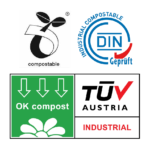 |
| North American ASTM D 6400 Standard | 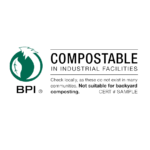 |
| Australian AS 4736 Standard | 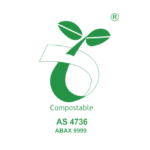 |
Watch out for logos that look similar but actually certify home-compostable or bio-based plastics, like these:
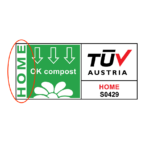 |
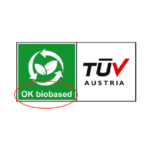 |
Related page: What exactly are “bioplastics?”